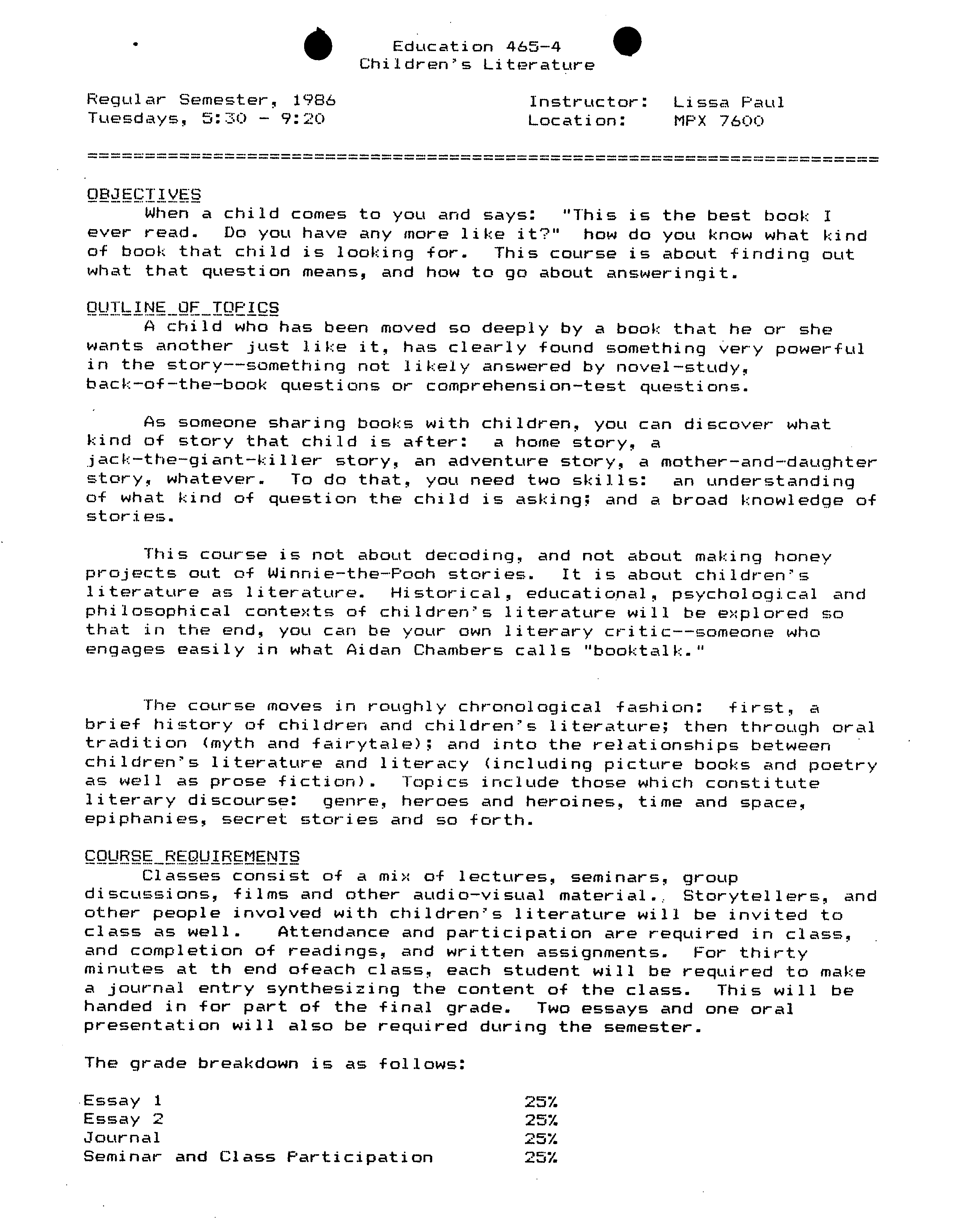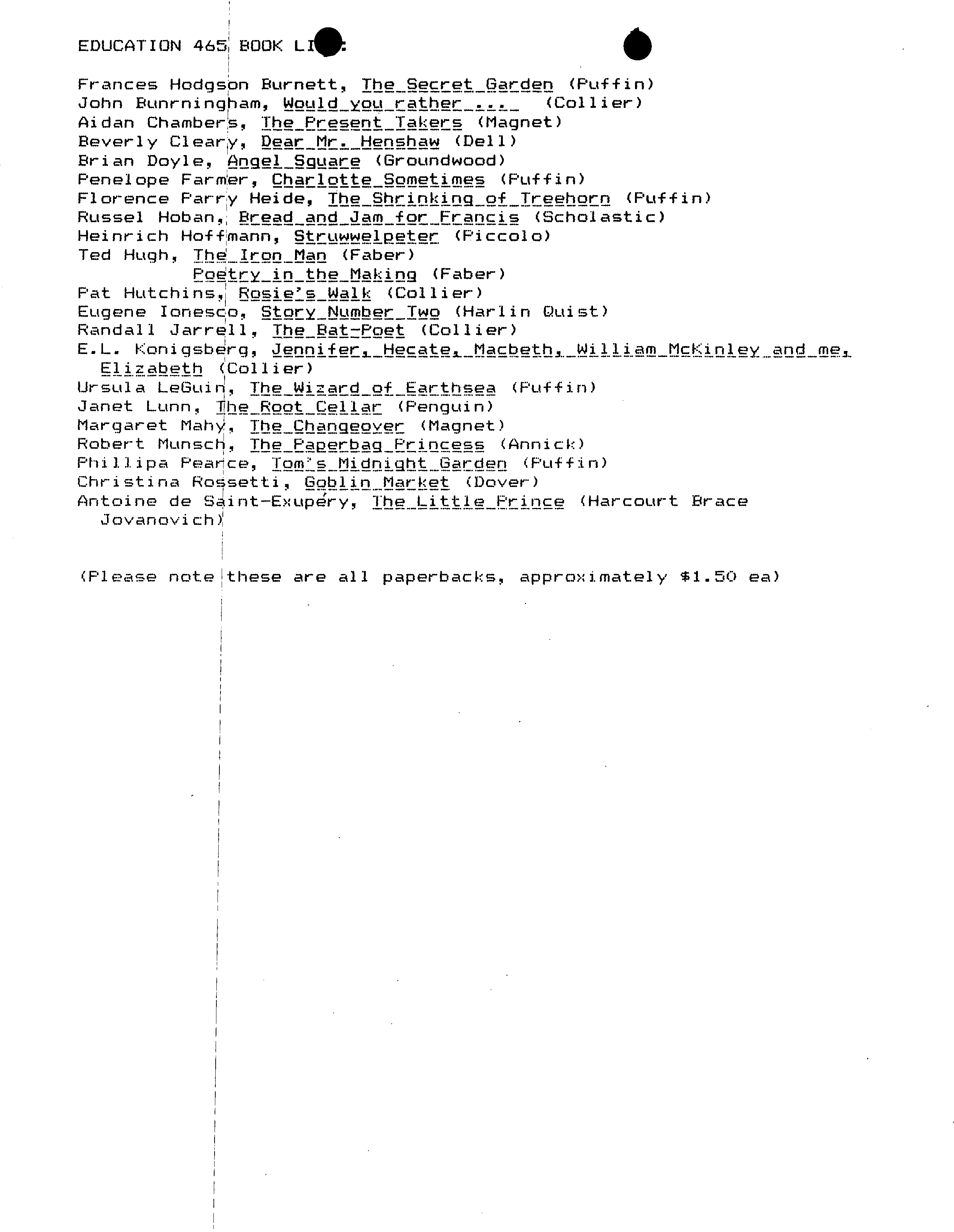Education 465-4?
Children's Literature
Regular Semester, 1986
?
Instructor: Lissa Paul
Tuesdays, 5:30 - 9:20
?
Location: ?
MPX 7600
OBJECTIVES
When a child comes to you and says: "This is the best book I
ever read. Do you have any more like it?" how do you know what kind
of book that child is looking for. This course is about finding out
what that question means, and how to go about answerinqit.
OUTLINE OF TOPICS
child who has been moved so deeply by a book that he or she
wants another just like it, has clearly found something very powerful
in the story--something not likely answered by novel -study,
back-of-the-book questions or comprehension-test questions.
As someone sharing books with children, you can discover what
kind of story that child is
after: a
home story, a
jack-the-giant-killer story, an adventure story, a mother-and-daughter
story, whatever. To do that, you need two skills: an understanding
of what kind of question the child is asking; and a broad knowledge of
stories.
This course is not about decoding, and not about making honey
projects out of Winnie-the-Pooh stories. It is about children's
literature as literature. Historical, educational, psychological and
philosophical contexts of children's literature will be explored so
that in the end, you can be your own literary critic--someone who
engages easily in what Aidan Chambers calls "booktalk"
The course moves in roughly chronological fashion: first, a
brief history of children and children's literature; then through oral
tradition (myth and fairytale); and into the relationships between
children's literature and literacy (including picture books and poetry
as well as prose fiction). Topics include those which constitute
literary discourse: genre, heroes and heroines, time and space,
epiphanies, secret stories and so forth.
COURSE REQUIREMENTS
Classes consist of a mix of lectures, seminars, group
discussions, films and other audio-visual material. Storytellers, and
other people involved with children's literature will be invited to
class as well.
?
Attendance and participation are required in class,
and completion of readings, and written assignments. For thirty
minutes at th end ofeach class, each student will be required to make
a journal entry synthesizing the content of the class. This will be
handed in for part of the final grade. Two essays and one oral
presentation will also be required during the semester.
The grade breakdown is as follows:
Essay 1
Essay 2
?
25
Journal
?
25%
Seminar and Class Participation
EDUCATION 46 BOOK
1 ?
L
4 ?
46
Frances Hodgson Burnett,
IbCt_o
(Puff in)
John Bunrningham, Would yo ?
(Collier)
Aidan Chamber, Ihe Present Takers (Magnet)
Beverly Cleary,
Dear Mr.
Henshaw (Dell)
Brian Doyle, ?
(Groundwood)
Penelope Farmer, Cha
r
lotte ?
(Puffin)
Florence Par ry Heide, T he
?
bn
(Puffin)
Russel Hoban,; Bread and Jam for Francis (Scholastic)
Heinrich Hoffmann, Struw ipeter (Piccolo)
Ted Hugh,
The
Iron Man (Faber)
Potry in the Making (Faber)
Fat Hutchins, ?
j_flç
(Collier)
Eugene lonesco, Story Number Two (Harlin Quist)
Randall Jarrell, The Bat-Poet (Collier)
E. L. Koni qsbrq,
?
nf ? cb
cKinleyand rne
Elizabeth (Collier)
tJrsulaLeGuirL The Wizard of Earthsea (Puffin)
Janet Lunn 'The Root Cellar (Penguin)
Margaret Mah, The Changeover (Magnet)
Robert Munsc ?
IbE g
?
(Annick)
FhiJlipa Ferc, I
?
Midnig
h
t Garden (F-u++Ln)
Christina Rossetti, Goblin Market (Dover)
Antoine de Saint-Eupery, Ihe Little Prince (Harcourt Brace
Jovanovi ch )
(Please note these are all paperbacks, approximately $1.50 ea)


